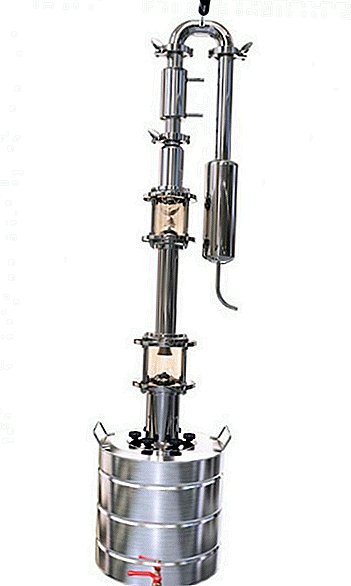 Manufacturers of home-made moonshine strive to ensure that their drink is clean from harmful fusel oils and without an unpleasant smell. To do this, they distil the product several times, as a result of which it is cleaned. And yet the best way to manufacture alcohol and alcohol-containing beverages is to use an apparatus with a distillation column. The principle of its operation and the possibility of self-production will be discussed in the article.
Manufacturers of home-made moonshine strive to ensure that their drink is clean from harmful fusel oils and without an unpleasant smell. To do this, they distil the product several times, as a result of which it is cleaned. And yet the best way to manufacture alcohol and alcohol-containing beverages is to use an apparatus with a distillation column. The principle of its operation and the possibility of self-production will be discussed in the article.
Description and principle of operation
As the moonshine still, the rectification column makes the moonshine, only of higher quality, purified. But above all, it is intended for the production of pure alcohol 96%, which is used as a basis in the preparation of various alcoholic beverages.  Alcohol is a product of distillation, during which the separation of alcohol-containing mixture (mash, crude alcohol) into separate fractions (methyl and ethyl alcohols, fusel oil, aldehydes) with different boiling points occurs as a result of repeated evaporation of the initial liquid and vapor condensation.
Alcohol is a product of distillation, during which the separation of alcohol-containing mixture (mash, crude alcohol) into separate fractions (methyl and ethyl alcohols, fusel oil, aldehydes) with different boiling points occurs as a result of repeated evaporation of the initial liquid and vapor condensation.
Next, we analyze the principle of operation of the column.
Distillation cube filled with alcohol-containing liquid is heated. In the process of boiling steam is intensively formed, which rises upwards along the column. There he is waiting for a reflux condenser, in which the steam is cooled and condensed.
Did you know? The largest distillation columns reach 90 m in height and have a diameter of 16 m. They are used in the refining industry.Drops of condensate (phlegm) descend into a column filled with steam. Cooled reflux runs down the special nozzles, which is found with hot steam. Between them there is a heat and mass transfer, which is repeated many times and is the essence of rectification.
As a result, pure vaporous alcohol is collected in the "head" of the column. For final condensation, it is discharged into the refrigerator, from which the distillate, that is, the finished product.
Video: distillation column and the principle of its work
The design of the home alcohol factory
The device of the rectification column consists of different parts, the dimensions of which need to be accurately calculated. For this design are needed:
- distillation cube, or container with alcohol-containing liquid;
- tsarga, or pipe, which will be the body of the column;
- a reflux condenser in which steam is cooled and condensed;
- nozzles that you need to fill the rye;
- distillate selection unit;
- water cooler;
- smaller parts for connecting parts of the structure and for monitoring its operation (thermometers, automation).
Consider each component of the device separately.
Distilling cube
The basis of the whole structure is the still. This is a container for alcohol-containing raw materials.
It can serve any vessel made of copper, enameled or stainless steel. Some self-racers use a pressure cooker for this if a small alcohol yield is expected.
And you can independently cook a suitable container from the sheets of "stainless steel".
Video: how to make do-it-yourself Main requirements that a cube must meet:
- absolute tightness: during boiling, the vessel should not allow vapor or liquid to pass through, and the lid should not be plucked from the growing pressure;
- a steam outlet that will appear if you plug a fitting into the cap.
If you buy a ready-made still, it already meets these criteria.  It is very important that the volume of the cube matches the size of the column. For a pipe with a height of 1.5 m and 50 mm in diameter, you need to take a capacity of 40-80 liters, for 40 mm of tsarg a 30-50 liter vessel fits, for 32 mm you need at least 20-30 l, and for a diameter of 28 mm you need an excellent suitable pressure cooker.
It is very important that the volume of the cube matches the size of the column. For a pipe with a height of 1.5 m and 50 mm in diameter, you need to take a capacity of 40-80 liters, for 40 mm of tsarg a 30-50 liter vessel fits, for 32 mm you need at least 20-30 l, and for a diameter of 28 mm you need an excellent suitable pressure cooker.
Important! The distillation cube needs to be filled with a brew of no more than 2/3 of its volume, otherwise the column will “choke when boiling".
Tsarga
The pipe in which the rectification takes place is called the kingdom. This is a cylinder with a wall thickness of 1.5 mm and a diameter of 30-50 mm. The effectiveness of the crutus depends on its height: the higher the pipe, the slower the harmful fractions are separated and the cleaner the alcohol is obtained.
The optimum height of the tsarga is 1-1.5 m. If it is shorter, then there will be no room for separated fusel oils in it, and they will be in the distillate. If the pipe is longer, then the rectification time will increase, and this will not affect the efficiency.  Tsarga rectification column with a nozzle For sale are ready-made bar for moonshine from 15 cm in length. You can buy 2-3 tubes and connect them into one. And you can make the ryga of the desired length yourself. To do this, you need a stainless pipe.
Tsarga rectification column with a nozzle For sale are ready-made bar for moonshine from 15 cm in length. You can buy 2-3 tubes and connect them into one. And you can make the ryga of the desired length yourself. To do this, you need a stainless pipe.
Video: how to make a rye for distillation columns independently Top and bottom need to cut the thread to attach the bottom to the cube, and attach a reflux to the top.
From the bottom, you also need to attach a grid to hold the nozzles with which the barrel will be filled. Some home experts wrap the pipe with insulation, for example, foam rubber.
Did you know? The Panchenkov nozzle was invented in the USSR in 1981 not for the manufacture of alcohol, but to improve the purification of crude oil for jet fuel..
Nozzle
Filling tsarga nozzles is a prerequisite for rectification. If the pipe is hollow, only a distillation process is possible in it, which will result in moonshine, but not pure alcohol. The purpose of the filler is to increase the surface on which the reflux flows.
Thus, the heavy harmful components are precipitated and cannot get into the final product, and a light steam of pure alcohol is removed. The filling should completely fill the tube.
The nozzle can serve as any filler from inert stainless material:
- glass or ceramic balls;
- stainless steel washcloths, finely chopped (from time to time they need to be changed, as the material deteriorates);
- Panchenkov nozzle (the best option), which is specially woven from copper or stainless steel. Its advantages: well precipitates phlegm and does not fail with time.
 Panchenkov's nozzle
Panchenkov's nozzleImportant! The nozzle bast has to be from a stainless steel. You can check it with a magnet: it attracts stainless steel.
Selection node
The selection unit is a small piece of pipe between the dorsal side and the dephlegmator. Its purpose is to collect phlegm: first go "heads", that is, harmful alcohol fraction, then goes "body", or alcohol without taste and unpleasant smell.  Homemade site selection all do differently, but on the same principle. For example:
Homemade site selection all do differently, but on the same principle. For example:
- to the outer tube, the diameter of which corresponds to the diameter of the tsarg, from the inside, weld a tube of smaller diameter so that between them along the circumference a pocket is formed, where a part of the phlegm will be collected;
- instead of a tube, a stainless plate is welded inside, corresponding to the internal diameter of the pipe, with a round hole inside: a part of the reflux will be collected on the plate, and some will fall through the hole back into the bar.
Video: do-it-yourself site selection Two holes for two unions are made in the pipe outside: a tap is attached to one to drain the reflux and a thermometer is inserted into the other (smaller) to measure the temperature of the steam.
Dephlegmator
The top of the structure is a dephlegmator. Here the steam is cooled, condensed and already in the form of droplets is sent down.  With your own hands, you can make several options for dephlegmators:
With your own hands, you can make several options for dephlegmators:
- Shirt or straight flow reflegmator It is made of two pipes of different diameter. Flowing water circulates between them, and inside the smaller pipe the steam turns into condensate. The outer tube can easily replace the thermos case, the neck of which is screwed to the selection unit. In the bottom of the thermos it is necessary to make a hole for the TCA, that is, the tube connection with the atmosphere, through which light unnecessary pairs will go out.
Video: direct-flow dephlegmator principle of operation
- Dephlegmator Dimrota more efficient than the previous model. The body is a pipe of the same diameter as the gut. Inside it is a thin tube, twisted by a spiral, in which cold water moves. If the diameter of the collar is 50 mm, then the spiral must be twisted from a tube with a diameter of 6 mm and a length of 3 m. Then the length of the dephlegmator will be 25-35 cm.
Video: assembly of a distillation column with Dimroth reflux condenser
- Shell-and-Pipe Dephlegmator consists of several pipes: small pipes are mounted inside the large ones, in which the steam condensation occurs. This model has several advantages: water is sparingly consumed and steam is rapidly cooled. In addition, this design can be attached to the column at an angle, which reduces its height.
Video: working principle of shell-and-tube dephlegmator
Fridge
A small refrigerator, or aftercooler, is needed to reduce the temperature of ethylene flowing from the extraction unit. It is made on the principle of shirt dephlegmator, but from tubes of smaller diameter.
Learn how to make apple moonshine.
It also has two passes for water: it enters the lower cold liquid, it comes out of the upper one and is sent up the silicone tubes up to the dephlegmator for the same purpose.
Water speed is regulated by the tap.
Video: how to make a do-it-yourself refrigerator for a distillation column
Tsarga pasteurization
The pasteurization board is not a required element of the column. On the one hand, it complicates the basic design. But on the other hand, it improves it, as it more thoroughly cleans the alcohol from the head fractions during the whole rectification.
It is a smaller bosom (30 cm) with an additional selection node. It complements the main rye. "Heads", as usual, come out of a dephlegmator, but not only at the beginning, but constantly.
Alcohol is collected from the lower selection of a small tsarga. This ensures maximum purity of alcohol. 
Automation
A long rectification process can last for hours. At the same time, it must be constantly monitored so that the “heads” and “tails” do not accidentally mix with the “body”. It will not be so tedious if you install good automation to control the rectification. For this purpose is intended BUR (rectification control unit). A block can do the following:
- turn on the water to cool at a certain temperature;
- reduce the power during the selection of phlegm;
- stop selection at the end of the process;
- turn off the water and heat after the tail end.
You can automate the process by setting a “start-stop” with a valve: when the temperature rises, it stops sampling, when it stabilizes, it resumes sampling.
You can do without automation, but it is much easier with it.
Video: Automation for distillation column
Advantages and disadvantages of the rectification method
Benefits:
- the finished product is the purest alcohol 96% without harmful impurities;
- in the distillation mode, you can make moonshine with the desired organoleptics;
- ethyl alcohol can be the basis of any alcoholic beverage;
- You can design the device for this yourself.
disadvantages:
- ethylene has no organoleptic source product;
- the rectification process is very long: no more than 1 liter of distillate can be obtained in an hour;
- ready-made designs are very expensive.

What material is preferable
Rectification is intended for maximum purification of alcohol from various impurities. The details that make up the column should not affect the quality or taste of the product. Therefore, the material must be chemically inert, non-rusty and does not affect the taste and smell of the distillate.
Best food stainless steel, that is, chromium-nickel stainless steel. It is chemically neutral and does not affect the composition of the product.
Tinctures are drinks made by infusing diluted alcohol, vodka or moonshine on various fruits, seeds, spices, fragrant and healing herbs. We recommend to learn recipes for making tinctures from: blackfruit, cherry, cranberry, black currant, plum, pine nuts, lilacs, apples and bison.
The distillation column can be called a new-generation moonshine, because it produces better quality alcohol. Making this device with your own hands is quite difficult. But if you make an effort, the festive table will always be headed by a natural and tasty home-made alcoholic drink.












